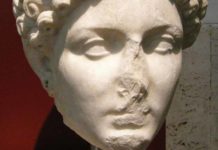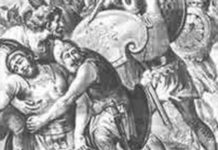The Julio-Claudian dynasty ruled the early Roman Empire and included Emperor Augustus, Emperor Tiberius, Emperor Caligula, Emperor Claudius, and Emperor Nero.
The early Roman Emperors brought Rome out of the time of the Republic and solidified it as an Empire. The Julio-Claudian dynasty produced the first five emperors, who were all related through blood or marriage in an effort to consolidate power and keep inheritance within the family.
The “Julio” came from the first emperor, Octavian, who was the great-nephew of Julius Caesar. The “Claudian” came from Octavian’s successors, the descendants of his second wife Livia and her first husband.
Emperor Augustus (Octavian) (r. 29 B.C.E.–14 A.D.)
Emperor Augustus, real name Octavian, initially ruled over the Republic with his fellow triumvirs Mark Antony and Lepidus, but after defeating Mark Antony at the Battle of Actium in 33 B.C.E. the Romans voted Octavian much more power. After Mark Antony committed suicide in 30 B.C.E., Octavian began to preside over the Republic alone.
Octavian had great personal and military authority, and gradually was granted or took enough power that he was effectively the emperor of the new Roman Empire. He was also involved in important administrative, legal, and judicial bodies. Octavian called himself princep, “first citizen,” but the senate also bestowed upon him the name of Augustus, “Revered One.”
Emperor Augustus was very popular with the Roman people and ushered in a Pax Romana, a period of peace and stability in Rome characterized by an economic upturn and a flourishing of Roman culture. He stabilized the Roman borders, bringing relative peace to everyone within the greater Roman Empire. He also undertook great building works, such as the Pantheon. He also was a patron of such poets as Virgil (The Aenead) and Horace.
Emperor Tiberius (r. 14–37 A.D.)
Emperor Augustus was succeeded by his stepson and son-in-law, the son of his scheming wife Livia and husband of his daughter Julia. Emperor Tiberius was an experienced administrator and general, and the Roman Empire experienced a smooth transition into his reign. Tiberius further solidified the Empire’s borders, and also helped stabilize the eastern part of the Empire. He oversaw tax and other financial reforms, and undertook various public building works.
Emperor Tiberius’s reign was not without problems, however. He lacked Augustus’s charm and diplomacy, and always had problems with the senate. Tiberius eventually semi-retired to Capri, leaving the Empire in the hands of Sejanus, the corrupt Prefect of the Praetorian Guard. Sejanus was eventually assassinated, and Tiberius himself died soon after.
Emperor Caligula (Gaius) (r. 37–41 A.D.)
The senate appointed Tiberius’s great-nephew Caligula to be the new Roman Emperor. His real name was Gaius, but he got the nickname Caligula, “little boots,” from the little soldier’s outfit he used to wear when he went on military campaigns with his parents when he was younger.
Originally, Emperor Caligula was very popular, as he was the son of the respected military commander Germanicus and the Roman people hoped that he would rescue them from the problems they’d suffered under Tiberius. But very soon in his reign he became a megalomaniac, spending a lot of money, engaging in depraved sexual acts, declaring himself a god incarnate, and killing his opponents, including some family members. He was eventually assassinated.
Emperor Claudius (r. 41–54 A.D.)
After Caligula’s assassination, the Praetorian Guard declared his uncle Claudius the new emperor. Claudius was not well known by the Roman people, as he had been largely kept from the public eye because of his stutter, limp, and general ill health. But he was intelligent and proved to be a competent ruler. He was also a noted historian and expert on various languages and ancient cultures.
As ruler, Emperor Claudius was an active administrator and was involved in the senate and courts, and also made many administrations more efficient. He undertook great building works, and added the territories of Britain, Thrace, and North Africa to the Roman Empire.
Emperor Nero (r. 54–68 A.D.)
Emperor Nero came to power at the young age of sixteen, his accession orchestrated by his mother Agrippina, Claudius’s fourth wife and niece, and her supporters. Under these advisors he actually ruled well for a while, administering well and attaining further victories in the east and Britain. But he eventually killed his mother and got rid of the other advisors, ushering in his own depraved reign.
Emperor Nero became a despot, ruling badly and fearing and killing anyone he thought was a rival. In 64 A.D., he was even blamed for the great fire in Rome. The legions eventually revolted, and Emperor Nero committed suicide.
The Julio-Claudian Emperors of the Roman Empire
The five Julio-Claudian emperors ushered Rome out of the period of the Republic and firmly established it as an Empire. Emperor Augustus, Emperor Tiberius, Emperor Caligula, Emperor Claudius, and Emperor Nero were men of varying administrative ability and personal authority, but they all had an important effect on how the Roman Empire developed.








